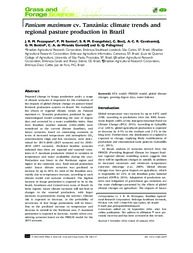Panicum maximum cv. Tanzânia: climate trends and regional pasture production in Brazil.
Panicum maximum cv. Tanzânia: climate trends and regional pasture production in Brazil.
Author(s): PEZZOPANE, J. R. M.; SANTOS, P. M.; EVANGELISTA, S. R. M.; BOSI, C.; CAVALCANTE, A. C. R.; BETTIOL, G. M.; GOMIDE, C. A. de M.; PELLEGRINO, G. Q.
Summary: Projected change in forage production under a range of climate scenarios is important for the evaluation of the impacts of global climate change on pasture-based livestock production systems in Brazil. We evaluated the effects of regional climate trends on Panicum maximum cv. Tanzânia production, predicted by agro-meteorological model considering the sum of degree days and corrected by a water availa bility index. Data from Brazilian weather stations (1963?2009) were considered as the current climate (baseline), and future scenarios, based on contrasting scenarios interms of increased temperature and atmospheric CO2 concentrations (high and low increases), were determined for 2013?2040 (2025 scenario) and for 2043?2070 (2055 scenario). Predicted baseline scenarios indicated that there are regional and seasonal variations in P. maximum production related to variation intemperature and water availability during the year. Production was lower in the Northeast region and higher in the rainforest area. Total annual productionunder future climate scenarios was predicted toincrease by up to 20% for most of the Brazilian area, mainly due to temperature increase, according to each climate model and scenario evaluated. The highest increase in forage production is expected to be in the South, Southeast and Central-west areas of Brazil. In these regions, future climate scenarios will not lead to changes in the seasonal production, with largerincreases in productivity during the summer. Climate risk is expected to decrease, as the probability of occurrence of low forage productions will be lower. Due to the predicted increase in temperature and decrease in rainfall in the Northeast area, P. maximum production is expected to decrease, mainly when considering scenarios based on the PRECIS model for the 2055 scenario.
Publication year: 2016
Types of publication: Journal article
Unit: Embrapa Dairy Cattle
Observation
Some of Embrapa's publications are published as ePub files. To read them, use or download one of the following free software options to your computer or mobile device. Android: Google Play Books; IOS: iBooks; Windows and Linux: Calibre.
Access other publications
Access the Agricultural Research Database (BDPA) to consult Embrapa's full library collection and records.
Visit Embrapa Bookstore to purchase books and other publications sold by Embrapa.

